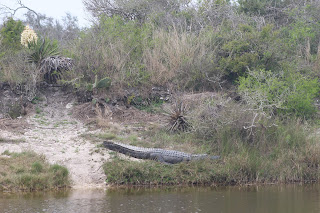It was March and we had not yet gone birding at the Aransas
National Wildlife Refuge. Having attended a lecture from Dr Elizabeth Smith, head
of the International Crane Foundation, our appetites were wetted to see more whooping cranes, and so we
packed lunches and headed out.
Our first stop was at Jones Pond, which was a shrunken marsh a
few years ago and now has flooded nearly to the refuge road. We usually see
alligators there but this year we saw common golden eyes, red heads, and blue wing
teal, all ducks.
Also present were American coot and a common gallinule, also called a
marsh hen.
Now there are about eight hundred and sixty whooping cranes
today of which five hundred and five call the refuge home, or in the
surrounding marshes, (this includes the birds in Lamar). We knew we would see a
few whoopers when we reached the viewing tower.
Sure enough, we did see two pairs
but they were far away, near the busy Intracoastal shipping channel. We also saw flocks of
ducks, also far away, and snowy egrets along with great blue herons.
In the trees nearby a funeral of turkey vultures roosted,
patiently waiting for something to die. A we walked down the tower walkway they
checked us out but lost interest as we were still moving. Driving along the eleven-mile
trail we had to stop so Renita could take a picture of an alligator sunning itself
along the road.
As she watched it, three raccoons ran across the road one
almost running over her feet! The alligator decided it couldn’t catch them, or
Renita, so it went back to its siesta. There were lots of sign of feral hog
activity alongside the road way, and they are a constant plague across the
south.
We ate lunch in the truck and finished the eleven-mile drive
before we spotted several herds of deer on the side of the road. At the Heron Flats
Trail we parked and were besieged by mosquitoes. Still the wind was blowing and
at the observation platform, we were able to see a pair of whoopers.
It’s the first
time we have seen whoopers there in the twelve years we have wintered along the
Coastal Bend, (each whooper pair claims almost a square mile of territory and
defends it against all other mating pairs).
Now we usually walk down the trail itself, but the mosquitoes
were so thick that they drove us into the truck. Renita and Pam decided that they
wanted to look for alligators and they braved the blood sucking parasites. They
were rewarded with a close view of nine large gators.
One even, had just crossed the trail and surprised Pam as
she walked the gator trail, not noticing the tail drag marks.
Renita hurried back
to get me and when we returned, I almost stepped on a snake. There are eight-foot
diamond backs rattlers here along with coral snakes, copperheads, and of course
water moccasins.
I jumped a bit before I recognized the harmless snake, wondering
why I had forgot my walking stick/snake stick. The gators were huge and
plentiful, and one was about fifteen feet away from the trail. I did take a
picture of the whooper pair. We were also were treated to a yellow rump warbler
as it fed on flying mosquitoes.
As we walked back, or should I say, were driven back to the
truck by the mosquitoes, (dengue fever has occurred in southern Texas), We spotted a yellow rump warbler as it fed on flying mosquitoes.. Our last
stop was ta the alligator viewing pond, but it was anticlimactic after all the
gators alongside the Heron Flats trail.












Interesting post. so many gators, birds, snakes ans skeeters.
ReplyDelete